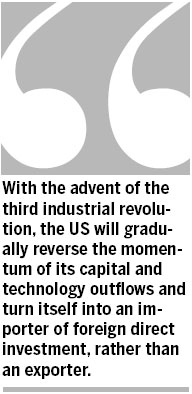

China will have to adjust its industrial strategy as soon as possible and try to achieve technological breakthroughs
Debates about how to pull the world out of its lingering financial difficulties and bring about an economic recovery are reaching the unanimous conclusion that a new industrial revolution is needed to revive the slackened global economy.
In the face of changes that some Western economists say will amount to a third industrial revolution, the question of whether China can achieve an economic transformation and avoid the end of the "made-in-China" period poses an unprecedented challenge to the world's second largest economy.
A new industrial revolution will change global economic conditions, as shown by the past industrial revolutions that ushered in the ages of "steam" and "electricity". The third industrial revolution, which many economists describe as concerning "intelligent manufacturing" and "low-carbon energy", is expected to follow much the same old path.
From promoting "de-industrialization" to turning to "re-industrialization", the United States has exhibited a greater intent to take advantage of the emerging third industrial revolution to introduce a new global industrial pattern.
Starting in the early 20th century and continuing for decades, the United States was the source of the largest number of manufactured products in the world. By about the 1950s, the US was producing about 50 percent of the world's total manufacturing output. That share, though, began to decline starting in the following decade. In the 1980s, developed economies were promoting manufacturing outsourcing and were primarily beginning to have service economies, which further aggravated the "industrial hollowing out" of the US and other Western countries. Amid these circumstances, the US' manufacturing share declined to 21.5 percent of the world's total in 1990 and to below 20 percent in 2009. It further declined to 19.4 percent in 2010, slightly lower than China's 19.8 percent.
To curb the decline, the US has adopted the long-term goal of regaining the lost advantages of its manufacturing industry. Such an intention became particularly apparent in Washington's introduction of a "re-industrialization" strategy in the midst of the current global financial difficulties. By pushing for "re-industrialization", the US is by no means simply aiming to bring back manufacturing industries. Instead, it is seeking to make its industries into stronger competitors and develop high value-added manufacturing with the use of advanced-manufacturing technology, intelligent manufacturing, new energy, bio-technology and information technology.
Washington's lingering fiscal crunch has not curtailed this ambitious strategy. Despite being in an economic and fiscal predicament, the US has not reduced its inputs into technological research and development. Statistics show that the US' input into technological research and development accounted for 33 percent of the world's total in 2011. The US has now adopted an advanced-manufacturing plan and begun putting more money and technological resources into nanotechnology, high-grade batteries, energy materials, bio-manufacturing, new-generation microelectronics and advanced robots, all of which will boost the development of its advanced technologies and help the US gain a leading position in researching and developing advanced-manufacturing technologies.
Just as in the past two industrial revolutions, the third one is expected to have enormous effects on global production and distribution, as well as on capital flows. Companies in the new industrial revolution are not likely to rely greatly on production systems that were common in the past, such as those that used assembly lines, and will not find manufacturing costs to be one of their most crucial expenses.
That means companies will no longer compete quite so much by trying to offer the lowest prices on final products of roughly the same quality. Instead, most will compete by trying to sell products with high added values. Such competition is expected to pose a challenge to China's manufacturing industry, which has an advantage in producing goods on a large scale at a low cost.
With the advent of the third industrial revolution, the US will gradually reverse the momentum of its capital and technology outflows and turn itself into an importer of foreign direct investment, rather than an exporter.
A challenge to China's manufacturing industry, meanwhile, comes from technological protectionism and monopolies in developed countries. China's ongoing industrial changes and its industrial improvements will increase the demand for new equipment and materials from the US and result in the rise of some direct competition. While strengthening its technological innovations, the US is also expected to take some measures to restrict its technological exports to China as it tries to preserve and hone its technological advantages. Such protectionist practices will possibly engender fierce competition between China and the US and intensify frictions over trade and intellectual property rights.
China, to prevent itself from being marginalized by the world's new industrial revolution, should adjust its industrial strategy as soon as possible and try to achieve technological breakthroughs to ensure it is better poised to take advantage of the coming industrial revolution.
The author is an economics researcher with the State Information Center.
(China Daily 09/05/2012 page8)